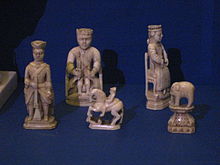
Ivory is a hard, white material from the tusks and teeth of animals, that consists mainly of dentine, one of the physical structures of teeth and tusks. The chemical structure of the teeth and tusks of mammals is the same, regardless of the species of origin, but ivory contains structures of mineralised collagen. The trade in certain teeth and tusks other than elephant is well established and widespread; therefore, "ivory" can correctly be used to describe any mammalian teeth or tusks of commercial interest which are large enough to be carved or scrimshawed.

The walrus is a large pinniped marine mammal with discontinuous distribution about the North Pole in the Arctic Ocean and subarctic seas of the Northern Hemisphere. It is the only extant species in the family Odobenidae and genus Odobenus. This species is subdivided into two subspecies: the Atlantic walrus, which lives in the Atlantic Ocean, and the Pacific walrus, which lives in the Pacific Ocean.

Tusks are elongated, continuously growing front teeth that protrude well beyond the mouth of certain mammal species. They are most commonly canine teeth, as with narwhals, musk deer, pigs, hippopotamuses and walruses, or, in the case of elephants, elongated incisors. Tusks share common features such as extra-oral position, growth pattern, composition and structure, and lack of contribution to ingestion. Tusks are thought to have adapted to the extra-oral environments, like dry or aquatic or arctic. In most tusked species both the males and the females have tusks although the males' are larger. Most mammals with tusks have a pair of them growing out from either side of the mouth. Tusks are generally curved and have a smooth, continuous surface. The male narwhal's straight single helical tusk, which usually grows out from the left of the mouth, is an exception to the typical features of tusks described above. Continuous growth of tusks is enabled by formative tissues in the apical openings of the roots of the teeth. Prior to over hunting and proliferation of the ivory trade, elephant tusks weighing over 90 kg (200 lb) were not uncommon, though it is rare today to see any over 45 kg (100 lb).
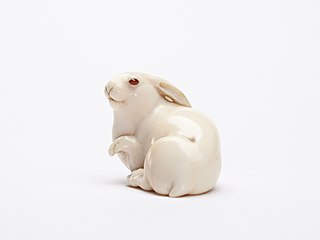
A netsuke is a miniature sculpture, originating in 17th century Japan. Initially a simply-carved button fastener on the cords of an inrō box, netsuke later developed into ornately sculpted objects of craftsmanship.

Dentin or dentine is a calcified tissue of the body and, along with enamel, cementum, and pulp, is one of the four major components of teeth. It is usually covered by enamel on the crown and cementum on the root and surrounds the entire pulp. By volume, 45% of dentin consists of the mineral hydroxyapatite, 33% is organic material, and 22% is water. Yellow in appearance, it greatly affects the color of a tooth due to the translucency of enamel. Dentin, which is less mineralized and less brittle than enamel, is necessary for the support of enamel. Dentin rates approximately 3 on the Mohs scale of mineral hardness. There are two main characteristics which distinguish dentin from enamel: firstly, dentin forms throughout life; secondly, dentin is sensitive and can become hypersensitive to changes in temperature due to the sensory function of odontoblasts, especially when enamel recedes and dentin channels become exposed.
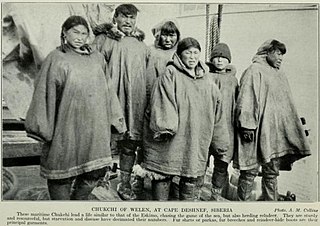
Uelen is a rural locality in Chukotsky District, just south of the Arctic Circle in Chukotka Autonomous Okrug in the Russian Far East. As of the 2010 Census, its population was 720. Located near Cape Dezhnev where the Bering Sea meets the Chukchi Sea, it is the easternmost settlement in Russia and the whole of Asia. It is located in the Western Hemisphere, but the International Date Line curves around it, so it remains in a Russian time zone (UTC+12:00). Uelen is also the closest Asian settlement to North America. It is on the northeast corner of the Uelen Lagoon, a roughly 15 by 3 kilometres east-west lagoon separated from the ocean by a sandspit. Municipally, Uelen is subordinated to Chukotsky Municipal District and is incorporated as Uelen Rural Settlement.

Scrimshaw is scrollwork, engravings, and carvings done in bone or ivory. Typically it refers to the artwork created by whalers, engraved on the byproducts of whales, such as bones or cartilage. It is most commonly made out of the bones and teeth of sperm whales, the baleen of other whales, and the tusks of walruses.
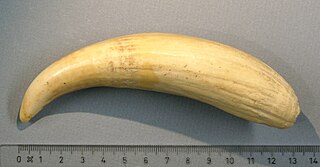
A tabua is a polished tooth of a sperm whale that is an important cultural item in Fijian society. They were traditionally given as gifts for atonement or esteem, and were important in negotiations between rival chiefs. The dead men would be buried with their tabua, along with war clubs and even their strangled wives, to help them in the afterlife. Originally they were very rare items, available only from beached whales and from trade from neighbouring Tonga, but when the market became known in the early 19th century thousands of teeth, and fake teeth made from ivory and walrus tusks entered the market. This trade led to the development of the European art of scrimshaw.

Ivory carving is the carving of ivory, that is to say animal tooth or tusk, generally by using sharp cutting tools, either mechanically or manually. Objects carved in ivory are often called "ivories".

Bone carving is creating art, tools, and other goods by carving animal bones, antlers, and horns. It can result in the ornamentation of a bone by engraving, painting or another technique, or the creation of a distinct formed object. Bone carving has been practiced by a variety of world cultures, sometimes as a cheaper, and recently a legal, substitute for ivory carving. As a material it is inferior to ivory in terms of hardness, and so the fine detail that is possible, and lacks the "lustrous" surface of ivory. The interior of bones are softer and even less capable of a fine finish, so most uses are as thin plaques, rather than sculpture in the round. But it must always have been much easier to obtain in regions without populations of elephants, walrus or other sources of ivory.

Olifant was the name applied in the Middle Ages to a type of carved ivory hunting horn created from elephant tusks. Olifants were most prominently used in Europe from roughly the tenth to the sixteenth century, although some were created later. The surviving inventories of Renaissance treasuries and armories document that Europeans, especially in France, Germany and England, owned trumpets in a variety of media and were used to signal, both in war and hunting. They were manufactured primarily in Italy, but towards the end of the fifteenth and early sixteenth centuries, they were also made in Africa for a European market. Typically, they were made with relief carvings that showed animal and human combat scenes, hunting scenes, fantastic beasts, and European heraldry. About seventy-five ivory hunting horns survive and about half can be found in museums and church treasuries, while others are in private collections or their locations remain unknown.
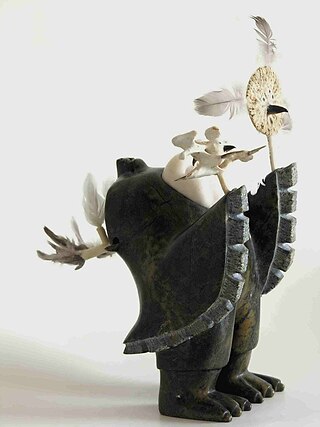
Inuit art, also known as Eskimo art, refers to artwork produced by Inuit, that is, the people of the Arctic previously known as Eskimos, a term that is now often considered offensive. Historically, their preferred medium was walrus ivory, but since the establishment of southern markets for Inuit art in 1945, prints and figurative works carved in relatively soft stone such as soapstone, serpentinite, or argillite have also become popular.

Alaska Native cultures are rich and diverse, and their art forms are representations of their history, skills, tradition, adaptation, and nearly twenty thousand years of continuous life in some of the most remote places on earth. These art forms are largely unseen and unknown outside the state of Alaska, due to distance from the art markets of the world.

A tooth is a hard, calcified structure found in the jaws of many vertebrates and used to break down food. Some animals, particularly carnivores and omnivores, also use teeth to help with capturing or wounding prey, tearing food, for defensive purposes, to intimidate other animals often including their own, or to carry prey or their young. The roots of teeth are covered by gums. Teeth are not made of bone, but rather of multiple tissues of varying density and hardness that originate from the outermost embryonic germ layer, the ectoderm.

The ivory trade is the commercial, often illegal trade in the ivory tusks of the hippopotamus, walrus, narwhal, black and white rhinos, mammoth, and most commonly, African and Asian elephants.
The conservation and restoration of ivory objects is the process of maintaining and preserving objects that are ivory or include ivory material. Conservation and restoration are aimed at preserving the ivory material and physical form along with the objects condition and treatment documentation. Activities dedicated to the preservation of ivory objects include preventing agents of deterioration that specifically connect with ivory as a material, preventative conservation, and treatment of ivory objects. Conservators, curators, collections managers, and other museum personnel are in charge of taking the necessary measurements to ensure that ivory objects are well maintained and will make the decision for any conservation and restoration of the objects.
African ivories are objects and materials that are created from ivory or include ivory material that comes from the continent of Africa. The ivory from Africa would become widely sought after by the 14th century due in part to the poorer quality of Asian ivory. While Asian ivory is brittle, more difficult to polish, and tends to yellow with exposure to air, African ivory often comes in larger pieces, a more sought after cream color, and is easier to carve. Ivory from Africa came from one of two types of elephant in Africa; the more desirable bush elephant with larger and heavier tusks or the forest elephant with smaller and straighter tusks.

Carved elephant tusk depicting Buddha life stories is an intricately carved complete single tusk now exhibited at the Decorative Arts gallery, National Museum, New Delhi, India. This tusk was donated to the Museum. This tusk, which is nearly five foot long, illustrates forty three events in the life of the Buddha and is thought to have been made by early 20th century craftsmen from the Delhi region.
Susie Paallengetaq Silook is a carver, sculptor and writer, of Siberian Yupik, Inupiaq and Irish descent. She was born in Gambell, Alaska.
Tom Akeya is an Inuit ivory carver. His work has been sold in multiple places.


